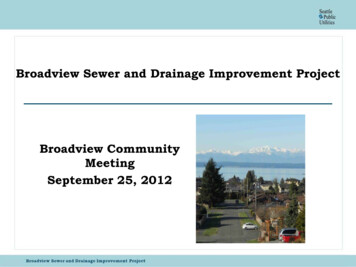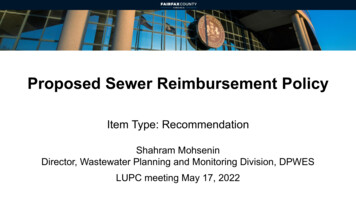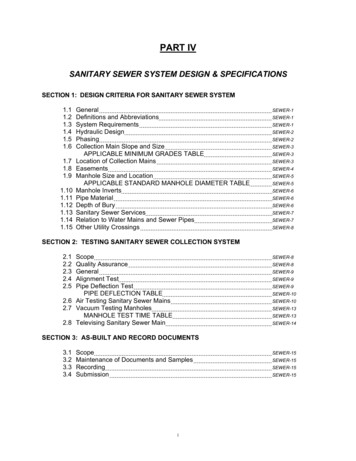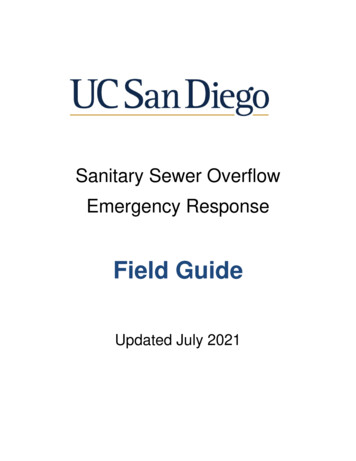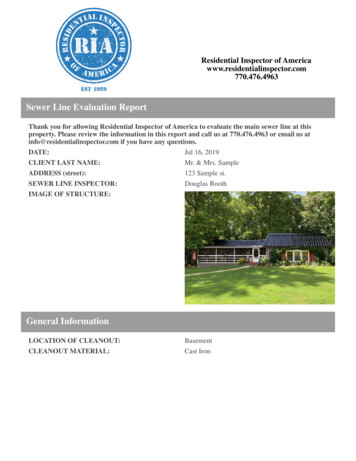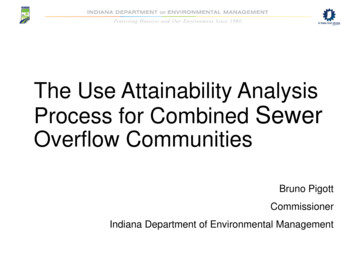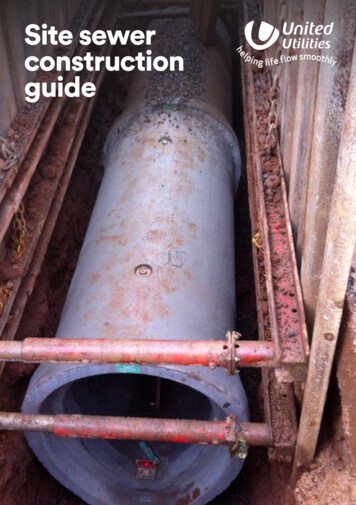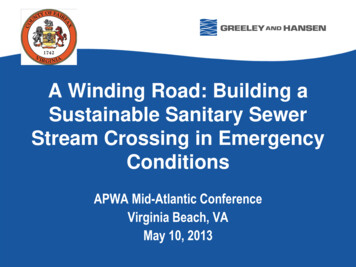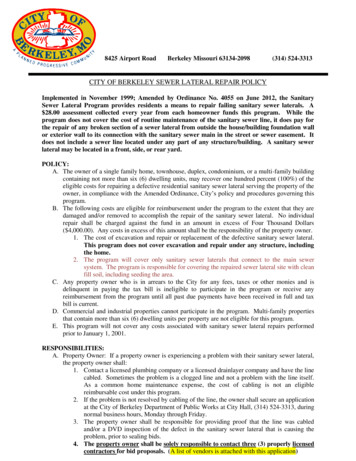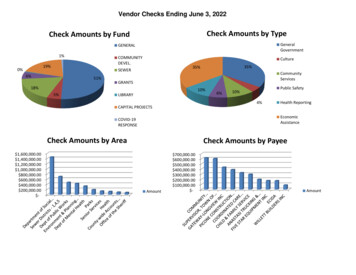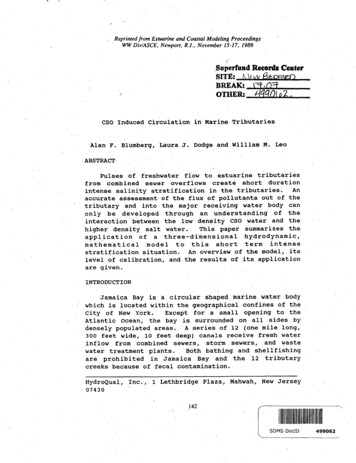
Transcription
Reprinted from Estuarine and Coastal Modeling ProceedingsWW Div/ASCE, Newport, R.I. November 15-17, 1989Superfund Records CenterSITE: M f v/v gfenFrtgnB R E A K ; P rwT rOTHER: *m()\t71.CSO Induced Circulation in Marine TributariesAlan F. Blumberg, Laura J. Dodge and William M. LeoABSTRACTPulses of freshwater flow to estuarine tributariesfrom combined sewer overflows create short durationintense salinity stratification in the tributaries. Anaccurate assessment of the flux of pollutants out of thetributary and into the major receiving water body canonly be developed through an understanding of theinteraction between the low density CSO water and thehigher density salt water.This paper summarizes theapplication of a three-dimensional hydrodynamic,m a t h e m a t i c a l model to this short term intensestratification situation. An overview of the model, itslevel of calibration, and the results of its applicationare given.INTRODUCTIONJamaica Bay is a circular shaped marine water bodywhich is located within the geographical confines of theCity of New York.Except for a small opening to theAtlantic Ocean, the bay is. surrounded on all sides bydensely populated areas. A series of 12 (one mile long,300 feet wide, 10 feet deep) canals receive fresh waterinflow from combined sewers, storm sewers, and wastewater treatment plants.Both bathing and shellfishingare prohibited in Jamaica Bay and the 12 tributarycreeks because of fecal contamination.HydroQual, Inc.074301 Lethbridge Plaza, Mahwah, New Jersey142SDMS DocID499062
M A R I N E TRIBUTARIES CIRCULATION (M W»*-««.pf-evlousstudies(Cataldo, etal1987)143haveshown.i .ifrrha»fe—fehe—«GSOsA to the head ends of the tributaries can,,.„r.rleach—fldwlAigalJls of over 1,000 cfs for a few hoursduring infe n'seTRainfall. These studies have also shownthat this water is considerably less dense than themarine water , in the tributaries.Density differencesbetween the storm water and marine water cause the stormwater to ride over the salt water resident in thetributaries.Indications are that the storm water isconfined to the top 2-3 feet of the water column in thetributaries. This density stratification results in thestorm water being transported into Jamaica Bay morequickly than if the entire volume of the tributary wereavailable to assimilate the storm water.This study focuses on 3 creeks to Jamaica Bay, knownas the 26th Ward Tributaries (Fresh, Hendrix, and OldMill Creeks, Figure 1) and examines the hydrodynamicresponse to freshwater pulses.By understanding themovements of storm water through the 26th WardTributaries, it will be possible to more accuratelycalculate the flux of bacteria and other pollutants intoJamaica Bay from CSOs into the tributaries.OBSERVATIONAL PROGRAMA four month water quality sampling program wasconducted during the summer, 1988, to provide data onthe impacts of combined sewer overflow (CSO) on thewater quality of Jamaica Bay and the 26th WardTributaries.Water samples were typically collectedfrom four locations along the length of each tributary(Figure 1) at depths of 1 ft. below the surface and 1ft. above the bottom. Samples were generally collectedevery 3-4 days throughout the summer during both wet anddry weather periods.During and after CSO events,samples were taken every 3-4 hours during daylight for 5days. The samples were analyzed for a wide range uctivity, temperature, and secchi depthmeasurements. Laboratory analyses included biologicaloxygen demand, total and volatile suspended solids,total and fecal coliform and a full complement ofchemical constituents.
ESTUARINE AND COASTAL MODELING14440.67 TIDE GAGE6 CURRENT METER40.66- FRESHWATERDISCHARGE WATER QUALITYSAMPLING LOCATIONSPRING CREEK 3.8873.8773.8673.8573.84LongitudeFigure 1.The study area and location of samplingstations
MARINE TRIBUTARIES CIRCULATION145T h e w a t e r quality sampling program w a s complimentedby a h y d r o d y n a m i c sampling program. T i d e g a g e s locatedin t h e 26th Ward Tributaries w e r e placed a t t h e h e a d s ofthe t r i b u t a r i e s , and a t 3 locations in t h e North Channel(Figure 1) and remained installed for a period o f 2 1/2months.In addition, 5 current m e t e r s w e r e deployedthroughout J a m a i c a B a y , o n e of w h i c h w a s located in t h eNorth Channel (Figure 1) for a period o f 30 d a y s w h i l ethe t i d e g a g e s w e r e . i n p l a c e . T h e c u r r e n t m e t e r in t h eN o r t h Channel w a s located about 20 f t . b e l o w t h e surfacein water of 35 ft. depth.Dye studies were alsoconducted in the 26th Ward Tributaries to provideinformation on the longitudinal and vertical mixing inthe tributaries.MODEL PHYSICSThe model used for this study is the time-dependent,three-dimensional estuarine, coastal and ocean model(EC0M-3D) developed by Blumberg and Mellor (1987). Thismodel has been used in numerous previous studies; amongthem are Blumberg and Mellor (1983) on the SouthAtlantic Bight, Oey et al. (1985) on the Hudson-Raritanestuary, Galperin and Mellor (1989) on Delaware Bay,Blumberg and Goodrich (1990) on Chesapeake Bay andBlumberg and Galperin (1990) on the New York Bight.The model is three-dimensional and responds tosurface wind stress, heat and salinity, fluxes, freshwater discharges and to the specifications of tidalforcing.Because non-linear terms in the equation ofmotion are incorporated by EC0M-3D, this model is,therefore, well suited also to the modeling of tidallyinduced mean flow.Spatial discretization on thevertical and horizontal dimensions are addressed byspatially variable coordinate systems, a topographicallyconformal and an orthogonal curvilinear, respectively.The reader is referred to the above referenced articlesfor a detailed description of the governing equationsand numerical techniques.
146ESTUARINE AND COASTAL MODELINGMODEL CALIBRATIONThe model domain is essentially the region shown onFigure 1. Included in the model domain is the NorthChannel region of Jamaica Bay and the three 26th WardTributaries. The grid spacing in the bay is 500 ft. inboth the east-west and north-south directions.Thetributaries aire laterally averaged with segments of 500ft. along the tributary axis and their actual width.There are three sigma levels iri the vertical.Thisresolution is only marginally sufficient to investigatethe physics of the circulation induced during a CSOevent.It does not resolve any small-scale eddyactivity which may be occurring.In this study,constant horizontal and vertical diffusivities formomentum and salt are used. These values as determinedthrough calibration are 3 m 2 s 1 and 2 c m 2 s 1 ,respectively.Typically, advective processes dominatethe vertical mixing during CSO events, therefore, anydependence of the vertical diffusivities on verticalshear and buoyancy is not critical so long as smallvalues of the diffusivity are used.The bottomroughness is 0.2 cm as suggested by Oey et al (1985).Elevation and velocity simulations, from July andAugust, 1988, were combined with the salinity profilescalculated for August, September and October, 1988, toevaluate the calibration of the hydrodynamic model.Examples of the comparison of model calculations withobserved data are presented in Figure 2.The upperportion of the figure shows velocity predictions duringJuly, 1988. The model appears to match the data verywell. The discrepancies towards the end of the periodcan be attributed to biofouling of the instrument, whichby July 15th rendered the data of little use.Theremaining part of the figure shows spatial and temporalsalinity profiles calculated and observed both in FreshCreek and Hendrix Creek during September 1988. Thelimited mixing between the fresh and saline water isobserved in both the data and the calculations. The
147MARINE TRIBUTARIES CIRCULATIONT—11 I' f! ' f 'III "T'Tt ffIZS N A A A A / W s A A— *--2 -4iiii10ii—.i11.i12.i13,.14ISJuly 1988Fresh CreekHendrix—i- i — i — i — — i — —1T11ICreek11I " II'rrHCl*—- — * «,—p.1" ir HC2so.10.CLc"5V*030V.1- ,FC2 i.i-i — ' — i — i—1iivll *10.1i, 1.1 J.rmi\[\m.m r FC3 0lT—i " v. v * *L,V30r1 C' fjry '2020iT - lffM 1—T-.l. — i — — * .-ass*P *10.FC40 -i12i13ii14IS1617 121314IS16September 1988Top sampleFigure 2.Bottom sample Comparison of model simulated currents ands a l i n i t i e s with observations.Stationslocations are denoted on Figure 1.
148ESTUARINE AND COASTAL MODELINGreason that Hendrix Creek experiences large tidaloscillations in salinity is due to the continuousdischarge of fresh water from the 26th Ward WWTP (Figure1) . Fresh Creek does not experience these oscillationsbecause discharges to Fresh Creek are limited to CSOs.It is readily apparent from the model result/datacomparisons afforded by use of Figure 2 that the modelis calibrated and simulates the essential physicalbehavior of the region. The model calibrations will befurther refined in future efforts by incorporatingimproved estimates of the CSO predictions and salinityboundary conditions.PHYSICAL RESPONSE TO CSO EVENTThe salinity distributions shown in Figure 2illustrate the dramatic changes in the tributaries dueto a CSO event which occurred on September 13, 1988 at 5AM and lasted for approximately 5 hours. To demonstratedetails of the system's response to a freshwater pulse,a sequence of vertical profiles of currents andsalinities from Fresh Creek will be used here.Initially pulse waters force surface salinitiesdownstream and out into Jamaica Bay proper while bottomsalinities remain somewhat constant (Figure 3) . Thisproduces a highly, vertically stratified situation witha greatly increased longitudinal salinity gradient. Thesecond stage of reaction to the pulse is the response ofthe density induced circulation. As the pulse decreasesbeginning at about 8 AM, there is a net transport ofsalt back up the tributary to a position beyond itsprepulse location due to the large, up-tributarydirected currents in the lower portions of the watercolumn. These large currents are forced by the enhancedlongitudinal pressure gradient. The final stage is onewhere vertical advection and mixing between surface andbottom waters and longitudinal advection result, in asalinity structure similar to that viewed before theevent occurred. The time for complete recovery is quiteshort, about 8-10 hours for these tributaries. A moreglobal view of this response is shown in Figure 4 whichillustrates surface and bottom currents at a time when
MARINE TRIBUTARIES CIRCULATION149- i — i — i — i — i — i — r v(VCD1015 0Sept. 13,19885AM1.0 ft/s100011200030004000500060007000 T—CL 0 60007000C uo-— Distance from Bulkhead(feet)Figure 3 .Time sequence of v e r t i c a lc u r r e n t s and s a l i n i t i e sthrough t h e CSO e v e n t .d i s t r i b u t i o n s ofi n F r e s h Creek
ESTUARINE AND COASTAL 0300040005000600070001000200030004000500060007000 uDistance from Bulkhead(feet)Figure 3 .Continued
MARINE TRIBUTARIES CIRCULATION40.66Sept. 13.1988-9AMSurfoce1.25 773.8673.8540.66Sept. 13,1988-9AMBottom1.25 ft/s40.65S340.6440.6373.86LongitudeFigure 4.Surface and bottom c u r r e n t s a t t h e time ofmaximum e v e n t - i n d u c e dtwo-layeredcirculation.151
152ESTUARINE AND COASTAL MODELINGthe system is responsing most strongly to the event.Surface currents in the tributaries are strong and bayward while the bottom currents are equally strong butdirected oppositely./CONCLUSIONSA joint program of field observations and threedimensional hydrodynamic modeling has been undertaken inthe 26th Ward Tributaries to acquire an understanding ofhow marine tributaries respond to freshwater (CSO)events.Comparisons of the model results withobservations indicate that the circulation can besimulated although some refinements to the boundaryforcing data are probably in order. The present resultsre-affirm much of what is known about physical responsesto CSO events and provide further evidence of thecomplexity of the response. Subsequent efforts will gotowards developing a coupled hydrbdynamic-water qualitymodel wiiich will address the significant variations inwater quality which occur during and subsequent to theevents.ACKNOWLEDGEMENTThis study was sponsored by the New York CityDepartment of Environmental Protection, CSO AbatementDivision. Appreciation is expressed to John P. St. Johnfor his guidance and to Boris Galperin, University ofSouth Florida, for his technical assistance.REFERENCESBlumberg, A.F, and Galperin, B. (1990). "On the summercirculation in New York Bight and contiguous estuarinewaters." Accepted in Residual Current and Long TermTransport in Estuaries and Bays. R.T. Cheng, Editor.Springer Verlag.Blumberg, A.F., and Goodrich, D.M. (1990). "Modeling ofWind-Induced Destratification in Chesapeake Bay."Estuaries. 13.
M A R I N E TRIBUTARIES CIRCULATION153Blumberg, A.F., and Mellor, G.L. (1987) "A Descriptionof a Three Dimensional Coastal Ocean CirculationModel," In: Three-Dimensional Coastal Ocean Models, N.Heaps, Ed.,. 1-16, American Geophys. Union.Blumberg, A.F., and Mellor, G.L. (1983) "Diagnostic andPrognostic Numerical Circulation Studies of the SouthAtlantic Bight." J. Geophvs. Res;. 88. 4579-4592.Cataldo, J.C., Ronan, A.D., Thatcher, M.L., and Ahmad,J. (1987). "Modeling stratified flow in combined seweroverflow." Journal of Hydraulic Engineering. 113. 2.,207-224.Galperin, B., and Mellor, G.L. (1990) "Salinityintrusion and residual circulation in Delaware Bayduring the Drought of 1984."Accepted in ResidualCurrent and Long Term Transport in Estuaries and Bays.R.T. Cheng, Editor. Springer Verlag.Oey, L.-Y., Mellor, G.L., and Hires, R.I. (1985) "AThree Dimensional Simulation of the Hudson-RaritanEstuary." Part I, II, III. J. Phys. Oceanogr. . 15.1676-1720.
water quality of Jamaica Bay and the 26th Ward Tributaries. Water samples were typically collected from four locations along the length of each tributary (Figure 1) at depths of 1 ft. below the surface and 1 ft. above the bottom. Samples were generally collected every 3-4 days throughout the summer during both wet and dry weather periods.
